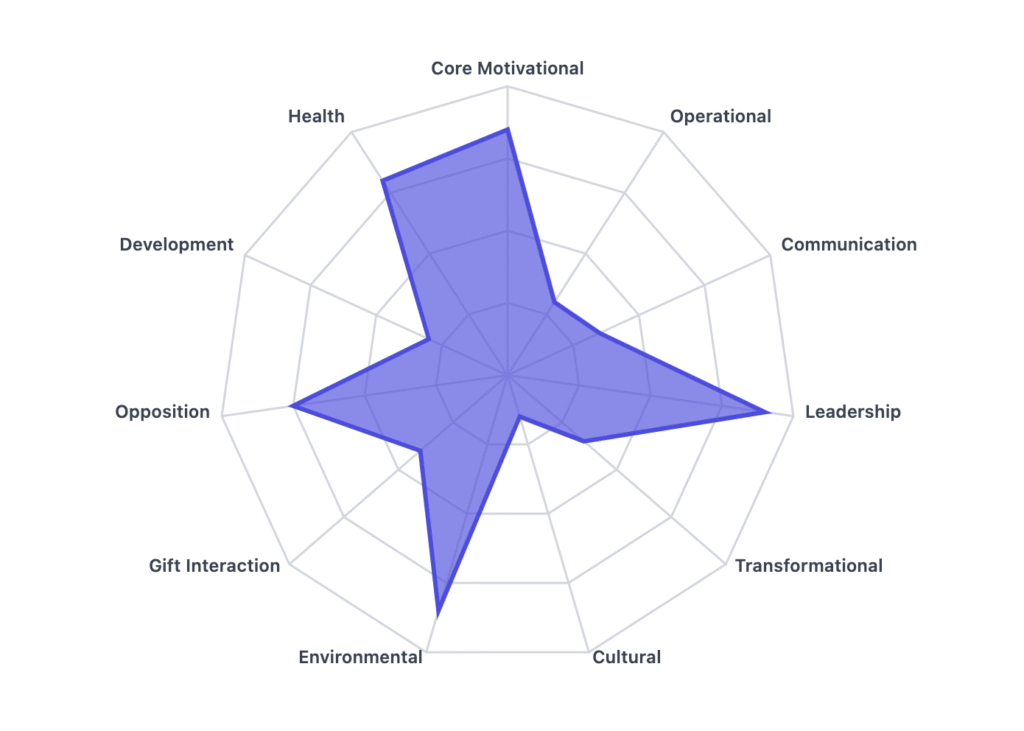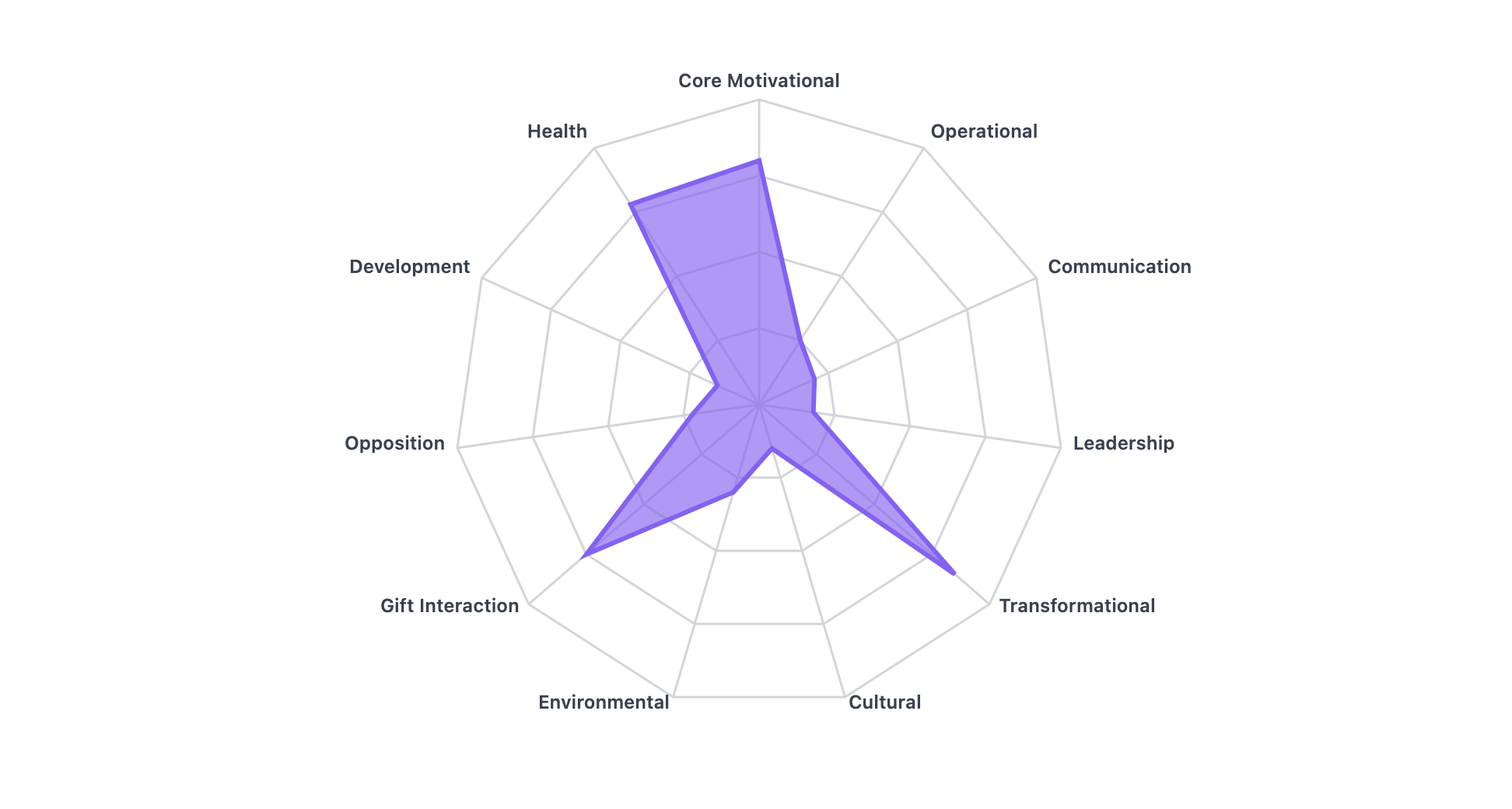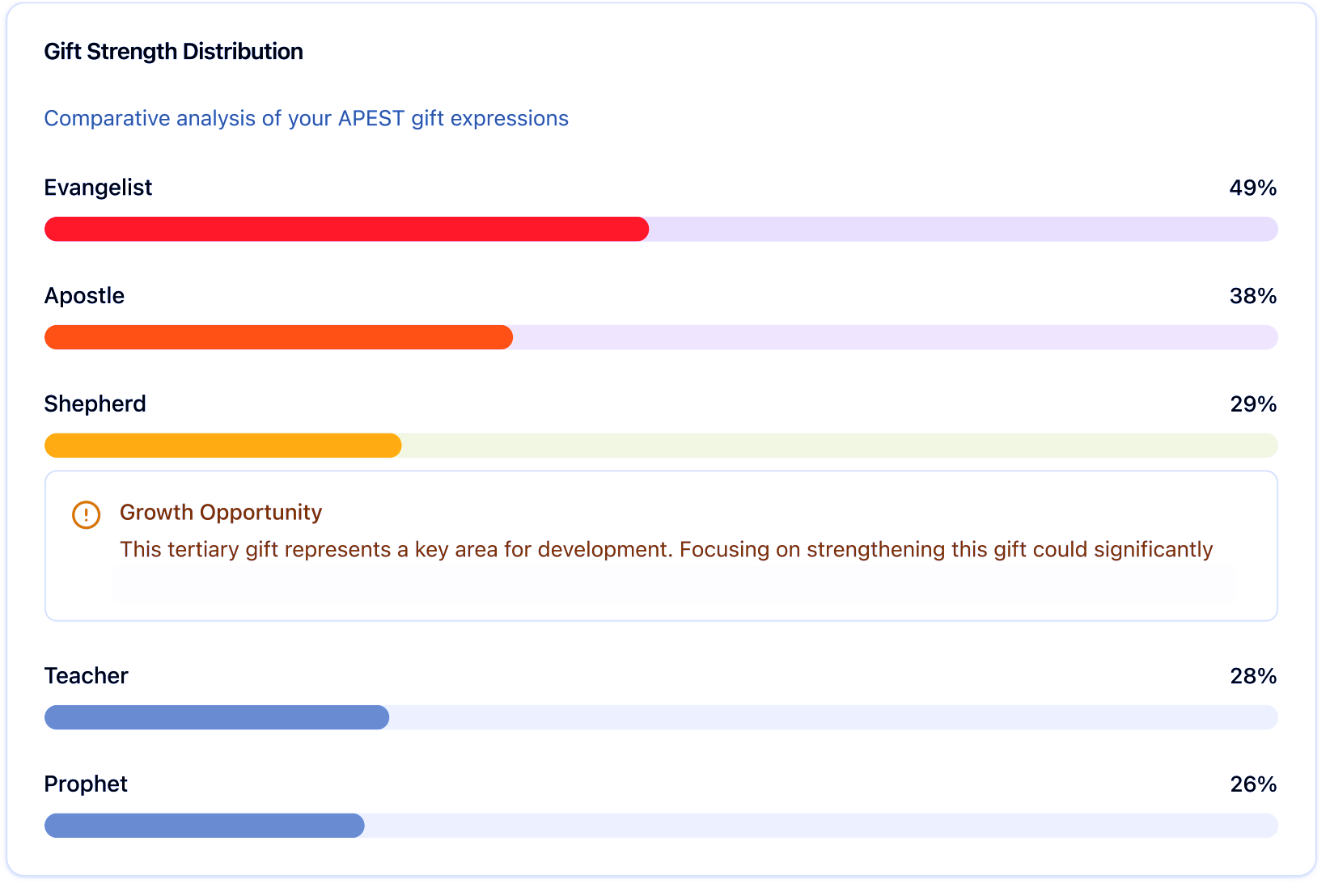APEST-11D™ Radar Dimension Analysis
- The radar shape is the message, not a score.
The shape is the message, not a score.
How to read your results
The shape is the message, not a score.
Each of the 11 dimensions on the radar chart displays the presence of your #1-ranked gift. If your #1 gift does not appear as primary in a dimension, that means another gift is leading there. Your #1 gift may appear as a tension (an additional gift you can access) in that dimension, or it may not appear at all.
Numerical scores were removed to ensure the chart is utilized as a diagnostic tool for understanding presence, not as a performance test.
These patterns are teaching examples. Your actual radar is a unique —real people don’t operate consistently across all dimensions, and your results reflect that authentic complexity.
Flexible Gift Expression
Pattern # 1 The Multi-Gift Leader
Assessment
What does this visual pattern mean?
- Varied peaks and valleys across dimensions
- No single dominant high or low area
- Dynamic, adaptive shape showing contextual flexibility
How do I understand the plot points?
- Areas are general size/expansion.
- Peaks are specific high spikes.
A valley is a low point/dip on the radar – where the shape comes closer to the center.
What does this visual pattern mean?
Your primary gift leads in some dimensions (such as Core Motivational Drivers or Leadership Expression), while other gifts take the primary role in different dimensions (such as Operational Functions or Cultural Expression). This pattern shows you’re not forcing your primary gift into every context. Different gifts step forward as primary based on the dimension’s needs.
This reveals you have developed the capacity to lead from multiple gifts, depending on which dimension you’re operating in. For example, in your “Operational Functions” dimension, you selected a different gift as primary, which is why the plotting is lower in that dimension.
Who has this pattern?
Leaders in diverse, multi-faceted roles who have developed the ability to shift between gifts based on context. Often found in senior leaders, coaches, or those in complex organizational roles requiring adaptive leadership across multiple domains.
Understanding tensions
When you selected tensions alongside your primary gift in any dimension, it means you’re able to pull from those gifts as well—not just your primary. Your framework selection (simultaneously, sequentially, or contextually) indicates HOW you access those tensions. Tensions aren’t secondary concerns—they’re additional gifts you can activate based on what the situation requires.

Your pattern is one-of-a-kind.
Infinite Variations, One Unique You
Your radar chart is a unique dimensional mapping—no one else operates exactly like you across all 11 dimensions. The reality is that nearly infinite variations exist.
Consistent Single-Gift Expression Without Tensions
Pattern #2 The Unwavering Specialist
What does this visual pattern mean?
• Medium-sized, symmetrical circle
• Consistent presence across all dimensions
• Smooth pattern showing unwavering single-gift expression
How do I understand the plot points?
- Areas are general size/expansion.
- Peaks are specific high spikes.
A valley is a low point/dip on the radar – where the shape comes closer to the center.
What does this visual pattern mean?
Your primary gifts leads consistently across many dimensions. The symmetrical circle indicates that you most likely selected the same gift in every dimension as primary, or your second and third gifts are close in percentage to your primary and are also reflecting high peaks and areas in every dimension.
The medium size indicates that you selected minimal or no tension in most dimensions, showing that you primarily operate from your single gift expression. You show up with your primary gift consistently—if you're a Prophet, you prophesy everywhere; if you're an Evangelist, you evangelize in every context. This unwavering consistency can be powerful in roles that align with your primary gift.
But it may also indicate limited flexibility when contexts require different gift expressions.
Who Has This Pattern?
Leaders with one highly developed gift that they rely on exclusively. This could be someone earlier in their development who is deeply initiated into one dimension of Christ through their primary gift, or an experienced specialist operating in a context where their single gift meets most demands. The pattern reveals a strong sense of gift identity, with potential for expanded gift expression through exposure to other APEST Gifts.
Understanding Tensions
When you selected tensions alongside your primary gift in any dimension, it means you're able to pull from those gifts as well—not just your primary. Your framework selection (simultaneously, sequentially, or contextually) indicates HOW you access those tensions. Tensions aren't secondary concerns—they're additional gifts you can activate based on what the situation requires.This visual breakdown shows which gifts you lean into most, which ones support you, and which areas hold growth potential. You'll see the complete picture of how Christ has equipped you, not just your primary, secondary, and supporting gifts.
Consistent Foundation, Contextual Leadership
Pattern #3: The Grounded Adapter
What does this visual pattern mean?
- High concentration in the Foundational category (dimensions 1-3)
- Varied, scattered pattern in Leadership & Complex categories
- Lopsided shape showing stable foundation with flexible adaptation
How do I understand the Plot Points?
- Areas are general size/expansion.
- Peaks are specific high spikes.
A valley is a low point/dip on the radar – where the shape comes closer to the center.
What does this visual pattern mean?
Your primary gift dominates your Foundational Dynamics (Core Motivations, Operations, Communication)—this is your stable presence and how you naturally function. However, in Leadership and Gift Int, different gifts take the lead in each dimension based on what that context requires. You have a consistent operational foundation while adapting which gift leads in different leadership and relational contexts.
Who has this pattern?
Leaders with a strong sense of core identity who’ve learned to contextually adapt their leadership approach. They know who they are foundationally but shift strategically in how they lead and navigate complexity.”
Understanding tensions
When you selected tensions alongside your primary gift in any dimension, it means you’re able to pull from those gifts as well—not just your primary. Your framework selection (simultaneously, sequentially, or contextually) indicates HOW you access those tensions. Tensions aren’t secondary concerns—they’re additional gifts you can activate based on what the situation requires.


Asymmetrical Development
Pattern #4 The Emerging Pioneer
What does this visual pattern mean?
- Sharp spikes in 3-4 specific dimensions (scattered across categories)
- Deep valleys in remaining dimensions
- Irregular, asymmetrical shape showing uneven development
How do I understand the plot points?
- Areas are general size/expansion.
- Peaks are specific high spikes.
A valley is a low point/dip on the radar – where the shape comes closer to the center.
What does this visual pattern mean?
Your primary gift leads strongly in 3-4 key dimensions scattered across Foundational, Leadership, and Complex categories, while selecting different gifts to lead in the remaining dimensions based on what each dimension requires. This creates an irregular pattern with sharp spikes where your primary gift dominates and valleys where other gifts take the lead.
Who has this pattern?
Emerging leaders, career transitioners, or ministry pioneers exploring new contexts. Common in younger leaders or those entering new roles where they’re discovering how their gifts apply across different dimensions. Also seen in experienced leaders who are reinventing their approach in unfamiliar territory.
Understanding tensions
When you selected tensions alongside your primary gift in any dimension, it means you’re able to pull from those gifts as well—not just your primary. Your framework selection (simultaneously, sequentially, or contextually) indicates HOW you access those tensions. Tensions aren’t secondary concerns—they’re additional gifts you can activate based on what the situation requires.
Consistent High Expression with Adaptive Capacity
Pattern #5 The Mature Practitioner
What does this visual pattern mean?
- Large, near-perfect circle
- Consistently high presence across ALL dimensions
- Minimal variation showing strong identity with multiple tensions indicating flexibility.
How do I understand the plot points?
- Areas are general size/expansion.
- Peaks are specific high spikes.
A valley is a low point/dip on the radar – where the shape comes closer to the center.
What does this visual pattern mean?
Your primary gift leads consistently across all dimensions. The large circular shape indicates that you have most likely selected the same gift as primary in nearly every dimension, establishing a clear gift presence.
What makes this pattern mature is the presence of tensions, showing that you can seamlessly access other gifts when the context requires it. You show up with your primary gift but have developed the sophistication to pivot to other gifts based on the situation.
Who has this pattern?
Highly experienced leaders with deep primary gift development AND contextual sophistication. They know who they are (consistent primary across all dimensions) but have learned to adaptively deploy other gifts when needed. Often seen in senior cross-cultural overseers, executive coaches, organizational consultants, or established ministry leaders who’ve mastered both identity clarity and operational flexibility
Understanding tensions
When you selected tensions alongside your primary gift in any dimension, it means you’re able to pull from those gifts as well—not just your primary. Your framework selection (simultaneously, sequentially, or contextually) indicates HOW you access those tensions. Tensions aren’t secondary concerns—they’re additional gifts you can activate based on what the situation requires.
Our APEST Assessment
Every question is designed to reveal how Christ’s gifts actually work through you.
Two-Gift Integrated Expression
Pattern #6 The Dual-Core Leader
What does this visual pattern mean?
- Distinctive two-peak irregular shape
- High concentration in 6-7 dimensions (one gift dominates)
- Lower but present in remaining dimensions (second gift leads)
- Asymmetrical pattern showing dual-gift integration.
How do I understand the plot points?
- Areas are general size/expansion.
- Peaks are specific high spikes.
A valley is a low point/dip on the radar – where the shape comes closer to the center.
What does this visual pattern mean?
Your primary gift leads strongly in about six dimensions (such as Operational Functions, Leadership, Environmental Needs, Gift Interactions, Opposition, and Development), while a different gift takes the primary role in the remaining five dimensions (such as Core Motivations, Communication, Transformational Objectives, Cultural Expression, and Health Metrics).
This creates a dual-core pattern where you operate from two dominant gifts depending on which dimension you’re in. Unlike the Multi-Gift Leader who shifts between many gifts, you primarily alternate between two strong gift expressions based on context.
Who has this pattern?
Leaders who have developed two strong gifts that share leadership across different contexts. Often seen in hybrid roles requiring two distinct operational modes—such as a teaching pastor who prophetically addresses issues, a shepherding apostle who plants churches with care, or an evangelistic teacher who connects truth with people. This pattern shows sophisticated gift integration between two primary expressions rather than single-gift dominance or multi-gift fluidity.
Understanding tensions
When you selected tensions alongside your primary gift in any dimension, it means you’re able to pull from those gifts as well—not just your primary. Your framework selection (simultaneously, sequentially, or contextually) indicates HOW you access those tensions. Tensions aren’t secondary concerns—they’re additional gifts you can activate based on what the situation requires.



